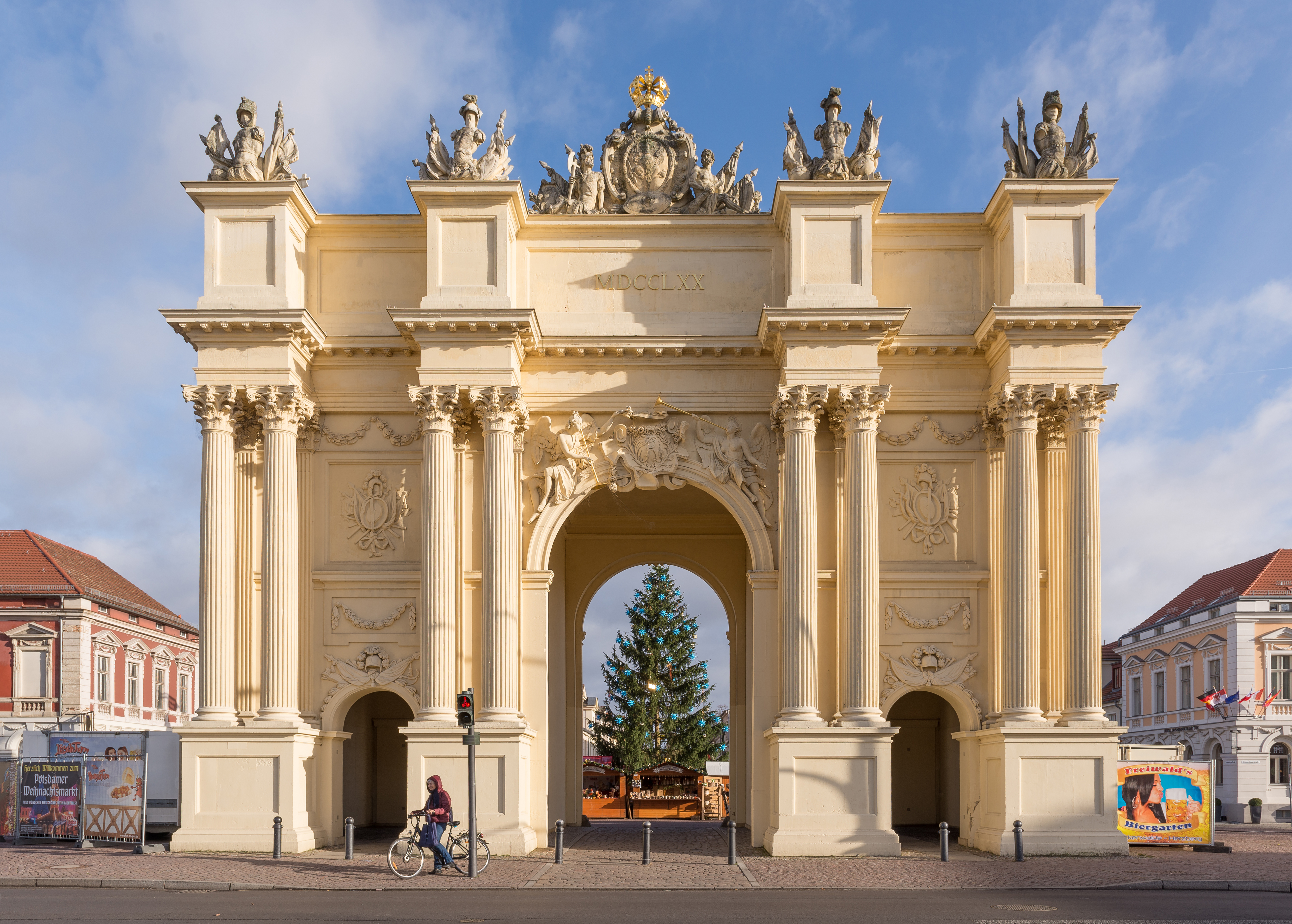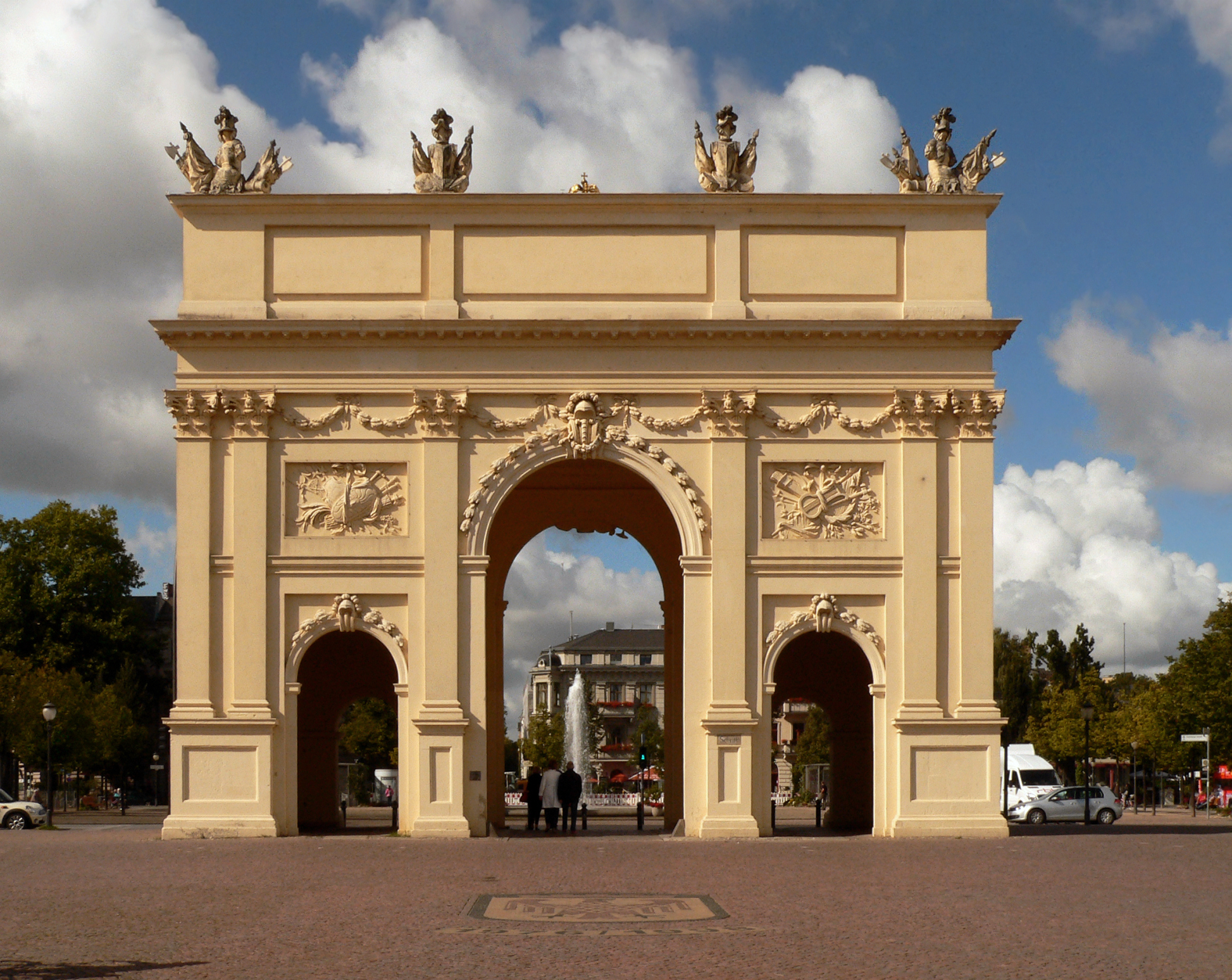Brandenburg Gate (Potsdam) on:
[Wikipedia]
[Google]
[Amazon]

 The Brandenburg Gate (german: Brandenburger Tor) on the '' Luisenplatz'' in
The Brandenburg Gate (german: Brandenburger Tor) on the '' Luisenplatz'' in

 The Brandenburg Gate (german: Brandenburger Tor) on the '' Luisenplatz'' in
The Brandenburg Gate (german: Brandenburger Tor) on the '' Luisenplatz'' in Potsdam
Potsdam () is the capital and, with around 183,000 inhabitants, largest city of the German state of Brandenburg. It is part of the Berlin/Brandenburg Metropolitan Region. Potsdam sits on the River Havel, a tributary of the Elbe, downstream of B ...
, not to be confused with the gate of the same name on Berlin
Berlin ( , ) is the capital and largest city of Germany by both area and population. Its 3.7 million inhabitants make it the European Union's most populous city, according to population within city limits. One of Germany's sixteen constitue ...
's ''Pariser Platz'', was built in 1770–71 by Carl von Gontard Carl Philipp Christian von Gontard (13 January 1731 in Mannheim – 23 September 1791 in Breslau) was a German architect who worked primarily in Berlin, Potsdam, and Bayreuth in the style of late Baroque Classicism. Next to Knobelsdorff he was c ...
and Georg Christian Unger
Georg Christian Unger (25 May 1743 – 20 February 1799) was a German architect who was a pupil of the architect Carl von Gontard and served Frederick II of Prussia. Among his works were the Brandenburg Gate (Potsdam), Brandenburg Gate in Potsdam a ...
by order of Frederick II of Prussia
Frederick II (german: Friedrich II.; 24 January 171217 August 1786) was King in Prussia from 1740 until 1772, and King of Prussia from 1772 until his death in 1786. His most significant accomplishments include his military successes in the Sil ...
. It stands at the western end of ''Brandenburger Straße'', which runs in a straight line up to the Church of St. Peter and St. Paul.
Previously, from 1733, there was another, simpler gate on the same spot, which resembled a castle gateway. Together with the city wall, a form of toll or excise barrier, and the other gates it was intended to prevent desertion and smuggling.
Towards the end of the Seven Years' War
The Seven Years' War (1756–1763) was a global conflict that involved most of the European Great Powers, and was fought primarily in Europe, the Americas, and Asia-Pacific. Other concurrent conflicts include the French and Indian War (1754� ...
, Frederick the Great had the old gate demolished and built, in its stead, this new Brandenburg Gate, as a symbol of his victory. For that reason the Brandenburg Gate resembles a Roman triumphal arch
A triumphal arch is a free-standing monumental structure in the shape of an archway with one or more arched passageways, often designed to span a road. In its simplest form a triumphal arch consists of two massive piers connected by an arch, crow ...
. Its prototype was the Arch of Constantine
The Arch of Constantine ( it, Arco di Costantino) is a triumphal arch in Rome dedicated to the emperor Constantine the Great. The arch was commissioned by the Roman Senate to commemorate Constantine's victory over Maxentius at the Battle of Milv ...
in Rome
, established_title = Founded
, established_date = 753 BC
, founder = King Romulus (legendary)
, image_map = Map of comune of Rome (metropolitan city of Capital Rome, region Lazio, Italy).svg
, map_caption ...
. The Roman influence of its architectural style can be seen, for example, in the double columns of Corinthian order
The Corinthian order (Greek: Κορινθιακός ρυθμός, Latin: ''Ordo Corinthius'') is the last developed of the three principal classical orders of Ancient Greek architecture and Roman architecture. The other two are the Doric order ...
as well as the design of the attic.
A feature of the Brandenburg Gate is that it has two completely different sides, designed by two architects. Carl von Gontard Carl Philipp Christian von Gontard (13 January 1731 in Mannheim – 23 September 1791 in Breslau) was a German architect who worked primarily in Berlin, Potsdam, and Bayreuth in the style of late Baroque Classicism. Next to Knobelsdorff he was c ...
designed the city side, his pupil, Georg Christian Unger, the field or countryside-facing side. Gontard made the city side as a rendered facade with Corinthian-style lesene
A lesene, also called a pilaster strip, is an architectural term for a narrow, low-relief vertical pillar on a wall. It resembles a pilaster, but does not have a base or capital. It is typical in Lombardic and Rijnlandish architectural building ...
s and trophies, Unger designed the field site in the style of the Arch of Constantine with Corinthian double-columns and ornamentation like the golden trumpets. The two side entrances for pedestrians were not added until 1843, under Frederick William IV, in order to cope with the increase in pedestrian traffic.
At that time people had to pass the Brandenburg Gate if they wanted to make their way to the town of Brandenburg, hence the name. The gate leads walkers into the city centre pedestrian zone of ''Brandenburger Straße'' in an easterly direction up to priory church of St. Peter and St. Paul.
Since the city wall was demolished around 1900 the Brandenburg Gate has been a free-standing structure.
Sources
* Paul Sigel, Silke Dähmlow, Frank Seehausen und Lucas Elmenhorst, Architekturführer Potsdam, Dietrich Reimer Verlag, Berlin 2006, .External links
{{Coord, 52.399539, N, 13.048003, E, type:landmark_region:DE-BB, display=title, format=dms Buildings and structures completed in 1771 Buildings and structures in Potsdam Gates in Germany Classicism Triumphal arches in Germany Prussian cultural sites Heritage sites in Brandenburg Tourist attractions in Potsdam Classicist architecture in Germany 1771 establishments in the Holy Roman Empire